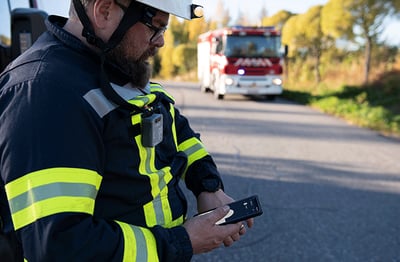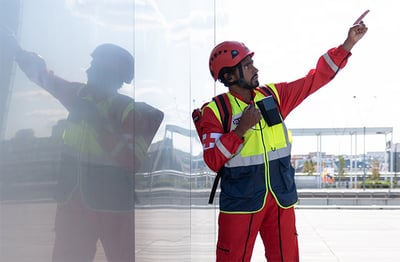A mission-critical smartphone must meet certain key requirements. These requirements cannot be met by a regular smartphone. But what are these key requirements? How do you choose a mission-critical smartphone? How do you manage smartphone risks for professional users? And how do you communicate when your mission-critical smartphone is out of coverage? This blog post answers these questions as well as many others about smartphones for professional users.
- Mission-critical – what does it mean?
- How to choose a mission-critical smartphone
- How to manage smartphone risks for professional users
- How to communicate when your smartphone is out of coverage
- How to deploy mission-critical smartphones
Mission-critical – what does it mean?
The term ‘mission-critical’ is used to describe a network, solution or application that must function reliably at all times. If the system does not work, there could be serious consequences. Mission-critical can be anything that is essential to survival.
Mission-critical smartphones require mission-critical broadband
To use broadband communications, public safety and other professionals first need to get mission-critical broadband connectivity.
If you think of broadband use as driving, the car is the smartphone and the access to broadband is the road. You need both before you can start driving.
Requirements for mission-critical broadband
In mission critical communication, information must be exchanged, or unfortunate things will happen. Professionals need their mission-critical communications to meet these three requirements:
- Efficient, secure group communications. Connecting groups instantly is the basis of professional communications. Group communication is how teams keep informed about the situation. This is achieved by a professional Mission Critical Push to Talk (MCPTT) app. This app must be very secure.
- Fast, reliable, and available connection. Availability means that the users can use the system when they need it.
- Proper prioritization. Priorities help guarantee that critical information will get through. They help the right people get connected when they need to.
Requirements for mission-critical smartphones
What is the meaning of mission-critical smartphone?
A smart device will not be mission-critical if it uses ordinary consumer broadband. It must have access to mission-critical broadband.
The first thing a professional needs is group communications. This means that mission-critical smartphones need PMR-like features in an app, such as Tactilon Agnet. A basic, mission-critical smart device will have mission-critical push-to-talk, push-to-data and push-to-video.
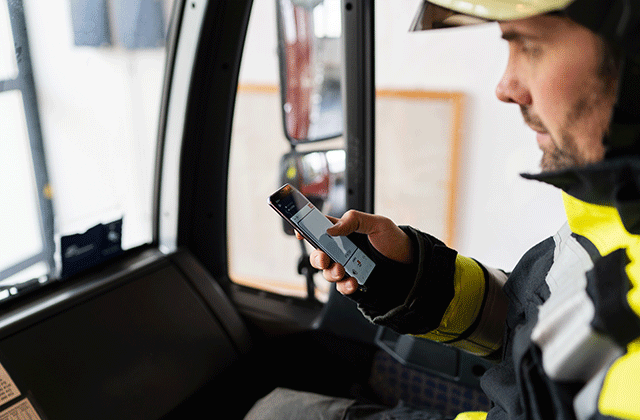
But, just putting a push-to-talk app on any smartphone does not make it mission critical. The app and smartphone must be able to work together. The smartphone must also be secure in all areas. These include hardware, bootloader, application containers, deployment and management. The devices must also be rugged.
Mission-critical smartphones must also receive updates to their operating system and security for many years.
Mission-critical smartphone operating time
Professionals expect their smart devices to have a longer lifetime and a longer operating time than consumer devices. There are eight great ways to make your device run for longer between recharges. You can see some of these in the blog post "Eight tips to extend the battery life for your duty smartphone".
Mission-critical smartphone ergonomics
A mission-critical smartphone must be easy to use throughout a working shift. When a mission-critical smartphone is used for MCPTT communications, it needs six features:
- Easy to use. Professionals need to concentrate on their work, so they need devices that are easy to use. They cannot waste time on complex sequences or trying to use small buttons.
- Excellent voice. Voice communication is important, and users expect excellent voice quality.
- Physical push-to-talk key. A smartphone used for push-to-talk needs a physical push-to-talk key. This is better than a push-to-talk button on the screen, especially for use over many hours.
- The emergency key needs to be easy to find without looking – but not too easy to activate so you won’t make false alarms.
- Long battery life. Public safety and other professionals usually work in shifts of 7-8 hours. During this time, the battery must supply power for a lot of apps - GPS positioning, camera, data services, group and one-to-one communications.
- Ruggedness. Professional tools must be water and dust proof, and resistant to shocks.
Which accessories and gadgets should I use?
Most public safety professionals still carry a traditional professional radio. It has been designed for a purpose. A mission-critical smartphone must also be fit for purpose. The device must work well with its accessories and gadgets.
For example, a smartphone should support professional-grade earpieces that are comfortable and stay in place. A wireless earpiece can be useful in the field.
How and where will you carry the phone? Wearable holders, belt clips and special pockets can be used on the move.
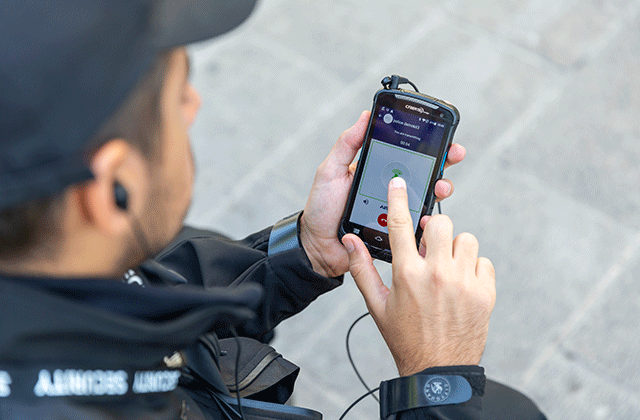
Learn more about professional accessories – read the blog post “Why professional smartphones need secure, special gadgets”. Or watch the video “How to use your smartphone as you would use your radio”. These show how to use a smartphone in a noisy environment, in an explosion-prone area and in an undercover operation.
How to choose a mission-critical smartphone
Which mission-critical smartphone to buy
Your TETRA or Tetrapol radio has been your most important tool for years. And on duty or off, you may also have your smartphone with you at all times. So, which public safety smartphone should you buy? Here are 8 quick tips to choosing a mission critical smartphone.
- Get the right size screen. You will want a bigger screen if you need to watch video on the go.
- Get the right kind of screen. You will want to use it even while wearing gloves.
- Make sure it is rugged. A rugged or heavy-duty smartphone is durable and works in all weathers.
- Make sure it is both IP65 and IP67 rated. A phone that is both IP65 and IP67 rated will work even in heavy rain or places with a lot of dust.
- Find one with loud and clear audio. Get a PTT app that optimizes the audio for voice. Your wired or Bluetooth loudspeakers, earpieces and microphones should work in all conditions. They should also work end-to-end with the device you choose.
- Choose a battery that will last a working shift on a single charge. Make sure you also get a changeable battery – instead of recharging the phone, you can simply change the battery.
- Check the device’s overall performance. Make sure the performance of the device meets all your needs – look at OS-version, software and hardware performance, audio and data interfaces and security.
- Make sure it’s easy to use. The device design must support using features and apps relevant for your use case, one hand operation, hands free, carrying concepts with accessories, vehicle kit etc.
Think carefully about the best rugged smartphone for your needs and look at all the features.
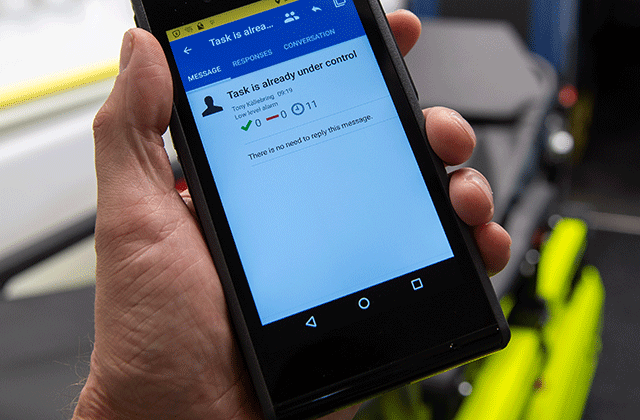
Make sure you can use a mission-critical communication solution (MCS/MCX), such as Tactilon Agnet. Without it, your smartphone will not be suitable for professional use. You would not trade in your radio for a smartphone if you did not get anything extra.
Handpicked related content
Watch this webinar recording: "Where is the mission-critical user experience heading in the next five years?". You will learn how user device design will develop in the future.
Would these eight advanced features work for you, too?
How would professional smartphones work in real life? How would a police officer use them to make their work easier?
Let’s imagine a police officer called John from a town called Securicity. During the first half hour of his working day, he might benefit from the following eight advanced features.
John’s morning routine begins at home and includes a large mug of coffee and reading the latest news on his phone. He can start his shift even before he finishes his drink.
- Single Sign On (SSO).
John logs into the Police IT environment on his smartphone and gets secure access to all the IT systems he needs. With secure SSO credentials, John is logged in with two factor authentication to everything he needs. And he uses them in a secure way. - Real-time presence.
John first checks the department schedule to see what he is doing today and who else is working. He sees he will be on patrol on the west side of town with a colleague named Tracy. - Instant messaging.
John uses Tactilon Agnet, the mission-critical communication solution (MCS/MCX) to send a secure text message to Tracy. He tells her he will pick up their patrol car and then pick her up in 25 minutes. With Tactilon Agnet, he does not need to know which device Tracy uses. She will get the message on her device, whether it is a radio or a smartphone. - And 5. Message board and secure, internal social media.
Before leaving home, John checks the night shift’s message board. It tells him about what has been going on and if there are any special risks today. He also uses his secure internal social media to check what is being discussed in the community and the control center – other officers can also automatically share relevant #hashtags that he should monitor.
Securicity has recently seen some riots by youngsters – using the message board helps the department track the culprits and prevent several potential riots. This was done just by sharing and collaborating – there was no need for a social media department.
With the internal Social Media, the shift that is ending can easily communicate with the shift that is starting. They do not need to involve the busy control center for simple catch-up messages. - Enhanced presence shows the status and location of all officers, their devices’ capabilities and current tasks.
As he leaves home, John changes his presence via smartphone to On Duty. His Control Centre knows he has reported in and can receive tasks, calls and messages. They also see John’s location on the map. They also know he is logged into the IT environment with his smartphone, using an LTE connection. - Video streaming from a drone or pushed from Control Centre.
John’s department has announced new guidelines for officers on patrol. The Control Centre knows that John uses a multimedia capable device. It will stream the newly recorded security guidelines video to John’s phone.
One of the new guidelines explains how to set up an overhead drone. This can deliver a live video feed to nearby phones. Officers can get an overview of a situation while staying at a safe distance. - Route planner.
From his patrol car, John plans the day’s patrol route. He can also see which areas other teams will patrol.
The head of the department has a real-time view of all the planned routes. He can see that his officers will again be very visible on the streets of Securicity.
With a real time route planner, officers can easily plan their routes for the day and ensure other users will know where they are.
The imaginary police officer John has used eight advanced features in the first half hour of his day. We can only guess at how these and other features will help him meet the challenges of the rest of his day.
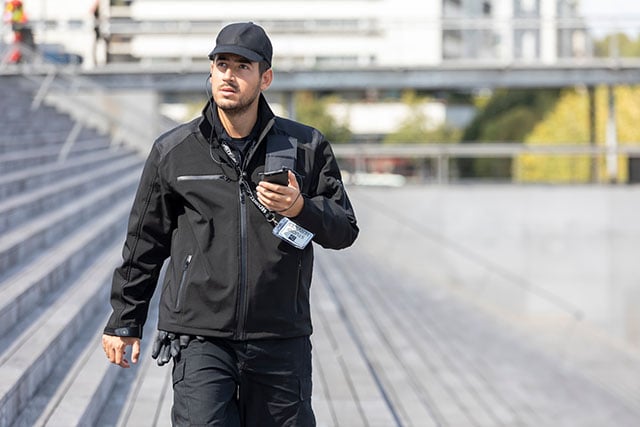
Mission-critical smartphone choices
Samsung devices
Samsung offers rugged smartphones, complete with task management and collaboration applications. The portfolio also includes military-grade rugged smartphones.
In addition, Knox is the defence-grade mobile security platform from Samsung. It protects the device with multiple layers of data security. It provides comprehensive security and device management protocols in the hardware, operating system (OS) and application layers. This guards against malware and data breaches and even protects lost or stolen devices.
Samsung is an important partner to Airbus in smart devices.
Tactilon Dabat hybrid device
Tactilon Dabat looks like a regular fully rugged smartphone. However, it is a mission critical smartphone and a TETRA radio in one device. It is designed for professionals who need to stay connected. They can rely on three networks: the TETRA network and a choice of private or public LTE network, with unique Smart and Hybrid Roaming features. The device will also know which broadband network to use. If the network is not available, Tactilon Dabat can connect directly to another device in Direct Mode Operation (DMO).
Tactilon Dabat is also ergonomic and easy to use. A smart dashboard holder called Ergo Plugin keeps users connected when moving in and out of the vehicle. Get the details on Ergo Plugin for Tactilon Dabat – download the datasheet. Or watch the video “How can you stay super connected between TETRA and broadband while on the move?”
Tactilon Dabat also has the familiar multi-purpose push-to-talk buttons used on Airbus TETRA radios.
Zebra smartphones
Zebra public safety smartphones and tablets meet the demanding needs of first responders. There are rugged models that are waterproof, drop-proof, dust-proof and tumble-proof. They also have a Gorilla Glass touch panel and imager window that resists scratches and breaking.
In addition, Zebra devices include dedicated buttons such as push-to-talk (PTT) and ‘most used function keys’ features, while the battery can also be changed easily during the shift. The devices have a long lifespan and also have their OSs upgraded to take advantage of similar features to those on traditional PMR radios. Zebra’s name is derived from the stripes making up barcodes, underlining its wide experience of data management apps.
Zebra is a collaboration partner to Airbus in smart devices.
Handpicked related content
If you are looking for a smartphone to use with Tactilon Agnet, the mission-critical communication solution (MCS/MCX), look in the Tactilon Agnet catalogue.
Smartphone security
Are smartphones secure?
Most consumer smartphones – even rugged ones – can be attacked by people trying to steal data. Other types of attack are aimed at software vulnerabilities in the browser, email, or operating system.
Because of these risks, using a smartphone can cause problems for professional organizations that need mission critical communications. Guarding against these risks means balancing high security and ease of use.
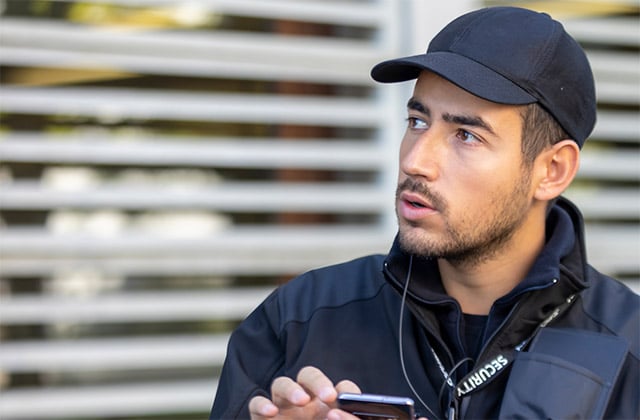
Smartphone security in general
Secure ways to use smartphones – Which is the most secure smartphone?
To keep your communications private, you need to look at conversation security. It is similar to information security and covers more than technology and features. Secure conversations and secure information depend on people and processes. You need to control access and identity, and also protect and monitor things. You also need a log to keep track of untoward events. This will allow you to investigate and resolve situations. Security breaches are embarrassing and expensive. Your communications solution must detect and respond to threats quickly and efficiently.
Safest secure smartphone
Regular smartphones are open and do not provide enough control over risks. Tactilon Dabat employs several methods to control risks. It is not open and so achieves optimal security for mission-critical users.
Handpicked related content
To learn how to guard against risks related to smartphones, download the white paper "How to manage smartphone-related security risks" or "How to manage smartphone risks for professional users". Or watch this webinar recording: "9 easy ways to improve your communication security".
Availability and reliability
A smartphone is mission-critical only when it runs on a mission-critical network. The network must be available, reliable and robust. It must continue to provide service when other systems fail or when parts of the infrastructure are off air or damaged.
What happens when a mission-critical smartphone is out of coverage?
TETRA users rely on their radios anywhere within the network area, and at any time. Where there is no network coverage, they can still communicate by sending signals between radios. This is called Direct Mode Operation (DMO).
Commercial mobile networks do not support Direct Mode yet. Even if they did, smart devices have limited output power. This means that device-to-device operation cannot reach very far. The range would be meters rather than kilometers like in TETRA.
There is one smart device that can work in Direct Mode – Tactilon Dabat. It can provide the most powerful solution for device-to-device communication.
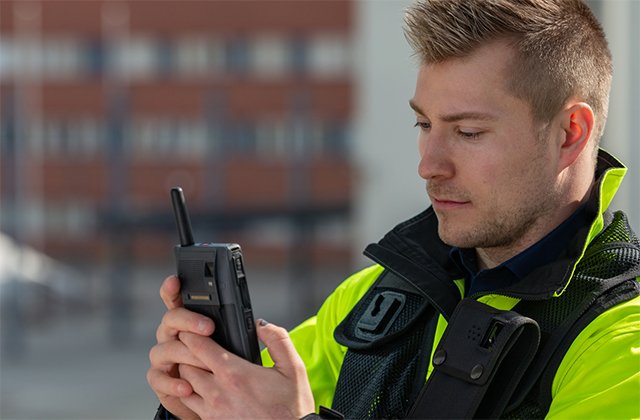
Quality of Service and mission-critical smartphones
The Quality of Service (QoS) of a mission-critical network measures its ability to achieve maximum bandwidth while also providing high performance. QoS also involves controlling and managing network resources. This is done by setting priorities for specific types of data (video, audio, files) and for specific types of users (mission-critical and others) on the network.
How can you monitor availability?
Knowing the availability of communication services in a commercial broadband network requires an end-to-end view of the service.
This information may not be available if the network elements are controlled by Mobile Network Operators (MNOs).
This overview can be gained by gathering information from smartphones and other smart devices. This is known as service analytics.
In practice, a special client will be set up in the mobile user devices, e.g. smartphones and other smart devices. The clients follow the levels of service that the devices (and thus the users) experience. Their reports are consolidated, and the results can be visualized. This shows accurately where the service is good and where it can be improved.
Handpicked related content
To learn about service analytics in more detail, download the white paper “Why service quality is something to think about today”.
Deploying mission-critical smartphones
The first things you need to know about adopting mission-critical smartphones and apps
Public safety organizations and businesses already use smart devices for non-critical purposes. With 5G technology, these organizations can have mission-critical broadband. This allows them to use smart devices in all their critical operations. How should organizations adopt this?
This blog post has the answers: “The first things you need to know when your organization wants to adopt mission-critical smartphones and apps”.
But that’s not enough. You will also need a mission-critical communication solution (MCS/MCX), such as Tactilon Agnet. Without it, your smartphone will not be suitable for professional use. You would not trade in your radio for a smartphone if you did not get anything extra.
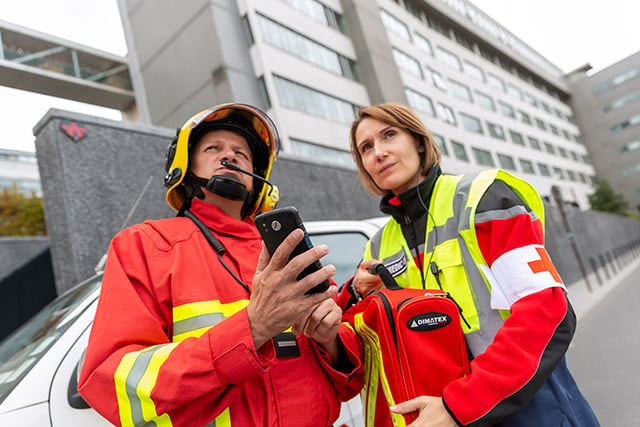
Here are 5 quick tips to help you choose a mission-critical communication solution (MCS/MCX) to pair with your professional smart devices:
- Get the right skills. You are the expert in your work tasks but specifying new technology may need other skills. You should select a partner or operator with the skills and experience to help you. They can specify use case technical requirements, build demos, plan integration, and maintain the solution. Making the right mission-critical solution is much more complex than with TETRA or TETRAPOL devices.
- Make a list of requirements for your next mission-critical smart device.
- Define the use case – what are the main features and requirements for your use case.
- Where and what do you need to communicate: voice, video, data?
- Environmental needs, duty length, wearable needs, accessories, gadgets, sensors, remote control, power management, outdoor or vehicle use.
- Take into account maintenance needs, lifecycle, and if needed, verify new replacing elements, including training of users. - Build a concept demo with several devices and accessories with connectivity options. Also show how to carry and use them in different situations.
- Test the concepts with typical users in a safe and controlled environment, simulating real life expectations. Improve the concepts based on feedback. Then repeat them until the demos match real needs.
- Fix the apps and devices lists, based on best concepts and start the purchase process with your partner or operator. And don’t forget to include maintenance, support, training and financing models.
To summarize –
This is nearly everything you need to know when your organization wants to use mission-critical smartphones professionally. These tips can help your journey from traditional radio communication to complementary and mission-critical broadband.
If you need advice getting started with mission-critical broadband and smartphones, the Airbus team can help. Take the next easy step – tell us a little about you:


